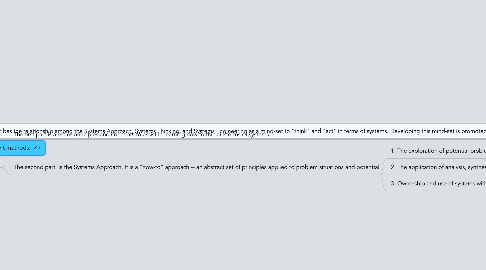Overview of the Systems Approach , Collected by vorachet@gmail.com 2011-11 , REF: INCOSE/BKCASE , Jackson and colleagues (2010, 41-43) define the Systems Approach as a set of top- level principles that provide the foundation of Systems Engineering. The Systems Approach implies taking a holistic view of a system that includes the full life cycle as well as specific knowledge of systems engineering technical and management methods.
por Vorachet Jaroensawas


1. Lawson (2010) describes the relationship among the Systems Approach, Systems Thinking, and Systems Engineering as a mind-set to "think" and "act" in terms of systems. Developing this mind-set is promoted by several paradigms including the System Coupling Diagram , which includes the elements Situation System, Respondent System, and System Assets
1.1. Situation System – The problem or opportunity situation, either unplanned or planned. The situation may be the work of nature, man-made, a combination of both natural and man-made, or a postulated situation that is to be used as a basis for deeper understanding and training (for example, business games or military exercises).
1.2. Respondent System – The system created to respond to the situation. The parallel bars indicate that this system interacts with the situation and transforms the situation to a new situation. Based on the situation that is being treated, a Respondent System can have several names such as Project, Program, Mission, Task Force, or in a scientific context, Experiment. One of the system elements of this system is a control element that directs the operation of the Respondent System in its interaction with the situation. This element is based on an instantiation of a Control System asset, for example a Command and Control System, or a control process of some form.
1.3. System Assets – The sustained assets of one or more enterprises to be used in responding to situations. System assets must be adequately managed throughout the life cycle so they will perform their function when instantiated in a Respondent System. These assets are the primary objects for Systems Engineers. Examples of assets include value-added products or services, facilities, instruments and tools, and abstract systems such as theories, knowledge, processes, and methods.
2. Systems Thinking
2.1. The first part is a set of principles and concepts to assist in learning how to think in terms of systems.
2.2. The second part is the Systems Approach. It is a "how-to" approach -- an abstract set of principles applied to problem situations and potential
2.2.1. 1. The exploration of potential problem or opportunity situations
2.2.2. 2. The application of analysis, synthesis, and proving to system solutions
2.2.3. 3. Ownership and use of systems within an enterprise

